Do you want to know how to gain 20 pounds of muscle mass? To get results, you need to optimize. So first, optimize your training to focus on achieving your goal. The best bodybuilders need an excellent diet to succeed. Thus, following an optimal diet and workout plan maximizes muscle gains. Here is a list of some of the best bodybuilders:
- Jay Cutler
- Arnold Schwarzenegger
- Big Ramy
- Brandon Curry
- Lee Haney
- Frank Zane
- Dexter Jackson
- Phil Heath
A goal needs daily commitment if you’re an ectomorph. This article will teach you the best way to build muscle with a bodybuilding five-day split workout plan and a lean bulk meal plan. Now, you can quickly enjoy serious muscle growth.
First, you must follow a proper workout and diet plan to gain 20 pounds of muscle. Want to transform your physique from skinny to muscular? We got you! Thus, we summarized everything about muscle growth regarding your training and diet adjustments. Let’s get started.
How Do You Gain 20 Pounds of Muscle with a Diet?
For gaining 20 pounds of muscle, what you eat is essential. Thus, you don’t need to consume a 2,000-calorie surplus to gain muscle. But, it would help if you ate enough to gain weight slowly. We call this lean bulk.
A slight surplus (lean bulking) optimizes muscle building. Thus, it circulates nutrients for maximal muscle protein synthesis. If you eat a caloric deficit, it would be impossible to build muscle. A calorie deficit puts your body in a catabolic state – breaking down tissue. You can only build muscle in an anabolic state.
According to a study published in 2004 by Sports Medicine, the optimal macronutrient ratio should be 55 to 60 percent carbs, 30 percent protein, and 15 to 20 percent fat.
Let’s explore that.
Protein –
Protein is the most crucial macronutrient to gain 20 pounds of muscle. Also, it is a staple in any bodybuilder’s meal plan. Amino acids are the building blocks of muscle. They repair and synthesize.
A recent systematic review and meta-analysis published by the British Journal of Sports Medicine assessed the optimal protein intake for muscle gain in 49 studies. Thus, this is arguably the most reputable source of analysis. In addition, the eligibility criteria for each study were a randomized controlled trial lasting over six weeks, the gold standard of research.
Subsequently, the researchers found that protein intake positively correlated with muscle size, but there was a cut-off point. Also, researchers discovered that a low protein intake stalled muscle hypertrophy. In addition, the upper limit of protein benefits stops at 0.7 grams per pound of body weight. Finally, the researchers concluded that 0.8 grams per pound was the maximum upper limit for protein intake. The study used a 95 percent confidence level. The confidence level was two standard deviations above the norm.
Carbs –
Carbs are also a staple in any bulking meal plan. However, they are best consumed around your workout to avoid gaining body fat. Also, this is because we store carbohydrates in the muscles as glycogen, the preferred fuel source for exercise.
Many studies have shown that glycogen affects muscle growth, particularly with individuals performing a high training frequency. However, too many refined carbohydrates can negatively alter your hormones and fat oxidation, which we do not recommend. So go for complex carbs, as included in the lean bulk meal plan.
Fat –
Fat is less discussed regarding its connection to gaining muscle. Subsequently, some believe that it slows down protein absorption and carbs. However, this isn’t well-established in the literature. In reality, healthy fats are essential for hormonal regulation and satiety. Eating a small amount at mealtime will help keep you full. Also, it will help to counter blood sugar spikes.
Sleep –
Muscle growth occurs when we sleep. We unknowingly activate specific pathways that trigger muscle degradation if we do not get enough sleep.
Studies show sleep deprivation causes a spike in cortisol (a stress hormone). Also, it reduces testosterone and insulin-like growth factor (IGF-1). These two hormones are integral to muscle building. Therefore, reducing anabolic hormones puts us in a catabolic state.
Thus, this means we break down muscle, no matter how heavy we lift. So, make sure you get high-quality sleep. Therefore, the standard is 8 hours per night.
Comprehensive Approach –
To build muscle fast, you can follow a diet that increases strength. For example, we aim to gain 20 pounds of muscle while cutting fat. Thus, it might be more difficult, but it’s possible. Also, a solid amount of evidence supports it.
For example, a 12-week study put a group of participants in a caloric deficit, high protein, and resistance training schedule. As a result, the group lost, on average, 9.3 pounds of fat and gained 8.8 pounds of muscle mass. Another similar study saw the participants lose fat and increase muscle mass, again consuming a high-protein diet.
The Journal of the International Society of Sports Nutrition studied a group of elite gymnasts on a hypocaloric ketogenic diet for 30 days. They continued to train while on a diet. Thus, on average, participants lost 2.6 percent body fat and gained 0.9 pounds of muscle mass. Subsequently, these elite athletes were training over four hours per day. Also, they only consumed 22 grams of carbs, lost fat, and gained muscle mass.
As you can see, total body recomposition is possible, helping you go from skinny to muscular. Thus, this is the fitness dream of many gym-goers. So now you understand the science, let’s see how to gain 20 pounds of muscle.
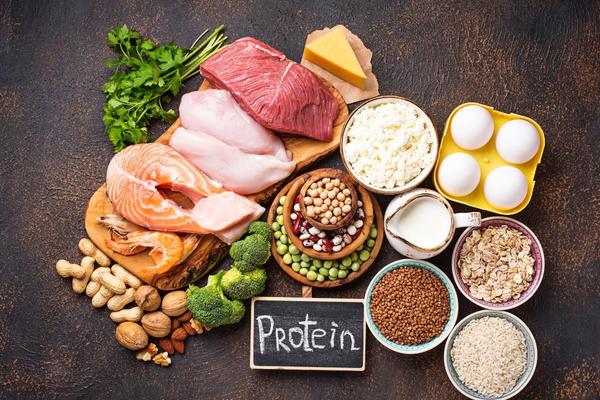
Lean Bulk Meal Plan
Depending on your macros, your portion sizes may be different. Double or triple the serving size, depending on your body metrics.
Breakfast –
- Eggs on toast
- Three eggs
- Two toasts
Protein: 31g Carbs: 30g Fats: 17g Calories: 400
- Protein Oatmeal
- ½ cup oats
- a scoop of whey protein powder
- tablespoon of peanut butter
- ½ cup low-fat milk
Protein: 32g Carbs: 35g Fats: 12g Calories: 300
- Veggie, egg, and cheese scramble
- Three eggs
- ¼ cup shredded cheese
- ½ cup veggies
Protein: 26g Carbs: ~12g Fats: 16g Calories: 290
Lunch and Dinner –
- Salmon and sweet potato
- Medium-baked sweet potato
- baked salmon fillet
- 2 tbsp sour cream
- 2 tbsp sesame seeds
- Handful of spinach
Protein: 45g Carbs: 53g Fats: 25g Calories: 550
- Chicken, veggies, and rice
- chicken breast
- 1/2 cooked onion
- 1/2 cooked bell pepper
- cup of cooked rice
- 4 tbsp salsa
- 2 tbsp sour cream
- 1/2 can of mixed beans
Protein: 45g Carbs: 109g Fats: 10g Calories: 725
- Steak, potato, veggies
- 8 oz steak
- medium potato
- 4 cups shredded cheese
- 2 tbsp sour cream
- 5 cups shredded lettuce
- cup of broccoli
Protein: 70g Carbs: 51g Fats: 23g Calories: 700
Snacks –
- Protein shake
- a scoop of whey protein
- tbsp of peanut butter
- 1/2 cup Greek yogurt
Protein: 34g Carbs: 128g Fats: 15g Calories: 320
- Greek yogurt mix
- 1/2 cup Greek yogurt
- a scoop of isolate whey protein
- banana
- Eight whole almonds
Protein: 38g Carbs: 109g Fats: 10g Calories: 430
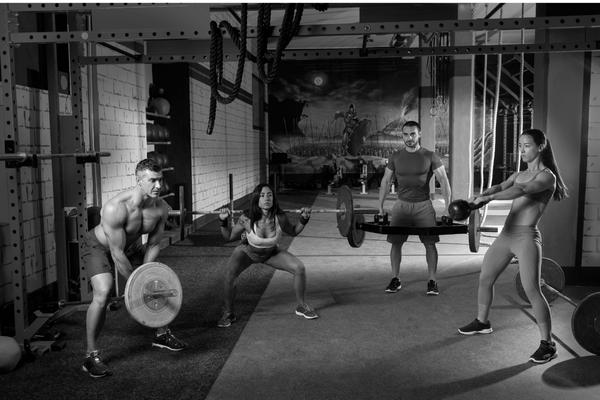
How Do You Gain 20 Pounds of Muscle with a Workout?
For muscle growth, you need to train your muscles properly. Subsequently, you lift weights, providing resistance for your muscles. Thus, you need to activate the three mechanisms of muscle hypertrophy. Finally, this is the process by which your muscles increase in size.
These mechanisms are:
- Mechanical tension is when your muscles are under pressure in an exercise. Also, it is the amount of force they need to complete the lift. Your muscles aren’t aware of the weight size, only how much tension the weight creates.
- Metabolic stress is a buildup of blood and oxygen deprivation (hypoxia) in the muscle, making it look ‘pumped.’ You achieve this by working at a high rep range (15-20+ reps) to pump blood into the muscle. Thus, this makes your cardiovascular system work harder, creating metabolic stress.
- Muscle damage happens when you implement progressive overload. Thus, increasing the weight in increments is the best. Also, you can decrease rest time, alter the tempo, do more reps, or do longer workouts. However, by doing this, you damage your muscles, causing micro-tears. Thus, each session begins the tear, repair, and growth cycle.
Both heavy and lighter loads target these three mechanisms. However, you don’t need to lift heavy to generate the maximum force during an exercise. Thus, you maximize force generation when lifting heavy enough to provide resistance. Also, you can control the exercise through slow movements (increasing time under tension).
Therefore, this recruits the highest motor units and muscle fibers. As a result, you will maximize mechanical stress and muscle damage. So, what does it look like to hit all three mechanisms during your training?
- Lifting heavy enough (to activate muscle fibers)
- Using a variety of rep and set ranges (for metabolic stress)
- Increasing the weight over time (for muscle damage)
- Performing exercises slowly (for mechanical tension)
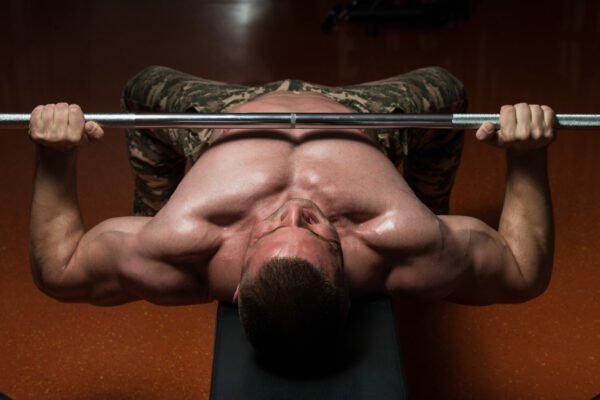
Chest Workout –
Barbell Bench Press
- Five sets; ten reps; cues: First, pull your shoulders back and down. Next, pull the bar off the rack. Then, pull the bar down to you. Also, pull the elbows in and push up. Finally, follow a straight line with the butt, head, back, and feet pressing down.
Incline Dumbbell Press
- Five sets; ten reps; cues: Lie back on an incline bench. Also, place a dumbbell in each hand atop your thighs. Thus, the palms of your hands will face each other.
Next, use your thighs to help push the dumbbells up. Finally, lift them one at a time to hold them at shoulder width.
Seated Chest Press
- Five sets; ten reps; cues: Sit comfortably on the machine with your feet firmly on the floor. Also, keep them about shoulder-width apart. Next, grasp the handles and push the bars outward to full extension. Also, do not lock out the elbow. Finally, keep your head and neck steady against the upright pad.
Cable Fly
- Five sets; ten reps; cues: Position two cables at chest height and attach a handle. Also, reach across your body and grab one handle with a neutral grip. Next, position the arms straight ahead. Then, hold on to each handle and keep a soft bend in the knees. Finally, pull inwards, flexing the chest.
Pec-dec Machine
- Five sets; ten reps; cues: Sit on the equipment, your back flat on the pad. Also, take hold of the handles. Next, push the handles together slowly as you squeeze your chest in the middle. Finally, return to the starting position gradually as you inhale until you fully stretch your chest muscles.
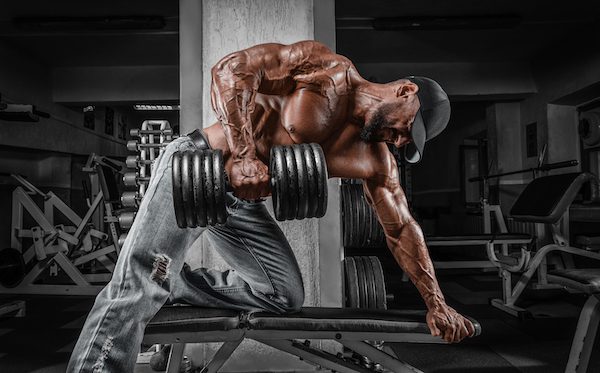
Back Workout –
Barbell Deadlift
- Ten sets; ten reps; cues: Stand with your mid-foot under the barbell. Also, bend over and grab the bar with a shoulder-width grip. Next, bend your knees until your shins touch the bar. Then, lift your chest and straighten your lower back. Finally, stand up with the weight while pressing the feet to the ground.
Wide Grip Pull-Ups
- Five sets; max reps; cues: Grab a pull-up bar with palms facing away from your body. Also, place your hands shoulder-width apart. Next, allow your arms to hang in a fully extended position. Then, keep your shoulders down and away from your ears. Finally, pull yourself until your chin clears the bar.
Standing T-bar Row
- Ten sets; ten reps; cues: Place the end of an empty barbell into the corner of a room. Also, use a heavy dumbbell or some weight plates to hold it down. Next, load and straddle the bar’s opposite end with plates. Then bend over at the hips until your torso is about a 45-degree angle to the floor with arms extended.
Wide Grip Seated Cable Row
- Ten sets; ten reps; cues: Bend your knees and hold the bar with an overhand grip, more than shoulder-width apart. Next, lean back slightly, keep your back straight, and use your back muscles to pull the bar towards your belly button. Finally, slowly return the bar to the starting position and repeat.
Close Grip Pull-Down
- Ten sets; ten reps; cues: Pull the bar down to your lower chest. Next, lean slightly and smoothly backward as you pull. Finally, gently release, allowing the bar to return to its original position while maintaining the stress on the back and arms.
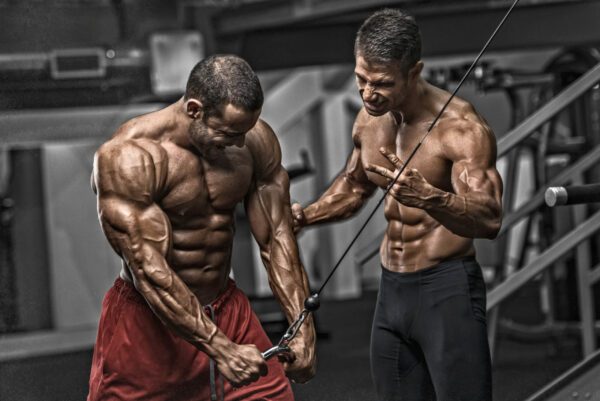
Arm Workout –
Tricep Pull-Down
- Ten sets; ten reps; cues: Pause when arms are straight to activate your tricep. Next, bend at the elbow, but keep your arms straight. Finally, gently return the bar to the starting position, maintain the arm’s stress, and repeat.
Curl to Press
- Ten sets; ten reps; cues: the bicep curl – only move elbows to bring weight towards your chest. Finally, go straight into a press.
Cable Face Pulls
- Ten sets; ten reps; cues: Put the cable around head height. Finally, pull the rope towards your face and squeeze your elbows back to activate your back.
Front Raise
- Ten sets; ten reps; cues: Keep the body still. Lift the barbell from the shoulders. Finally, stop when you get parallel to the chest and lower. Also, choose a weight light enough to keep your body still.
Side Lateral Raises
- Ten sets; ten reps; cues: Use a lower weight to ensure you can complete the exercise in a full range of motion. Also, keep your body still. Next, bend your elbows slightly. Finally, lift weights from the shoulder and don’t go above parallel to your shoulder.
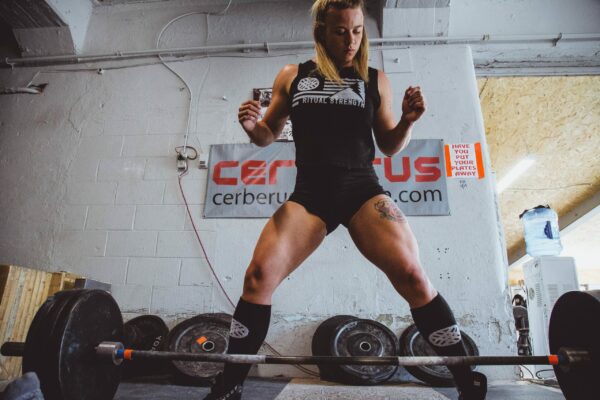
Leg Workout –
Barbell squat
- Three sets; ten reps; cues: Perform slowly, increasing time under tension. Next, go to 90 degrees as your flexibility allows. Also, keep the spine neutral. Finally, push through your heels when coming up.
Romanian Deadlift
- Three sets; ten reps; cues: Feet hip-distance apart and hands parallel on the bar; Let your knees naturally bend. Next, go just below your knees with the weight. Also, keep the spine and upper body straight and pull up from the lower body. Finally, hinge at the hip to lower the bar to the floor.
Leg Press
- Three sets; ten reps; cues: Squat movement; keep feet reasonably high. Also, point your toes pointed outwards. Finally, push through heels.
Leg Extension
- Three sets: ten reps: cues: Using your quadriceps, extend your legs to the maximum as you exhale. Next, slowly lower the weight to the original position as you inhale, ensuring you do not exceed the 90-degree angle limit.
Dumbbell Step-Up
- Three sets; twenty reps; cues: Perform slowly, increasing time under tension. Next, go close to 90 degrees as your flexibility allows. Also, keep the spine neutral. Finally, push through your heels when coming up.
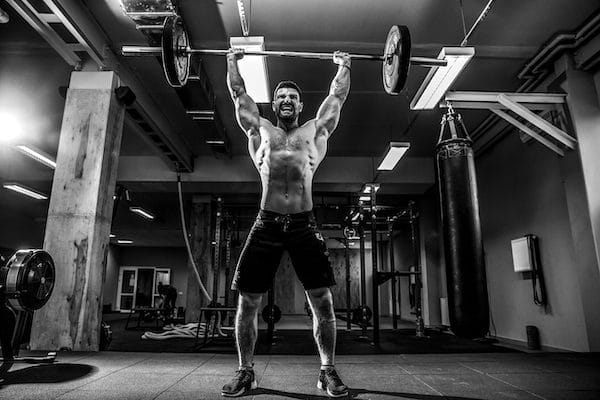
Shoulder Workout –
Narrow Grip Smith Machine Press
- Five sets; ten reps; cues: Sit on a bench with back support directly underneath the barbell of a Smith machine. Also, grip the bar with a double overhand, shoulder-width apart above shoulder height. Finally, gripping the bar as tight as possible, press it overhead until you lock your arms completely out.
Upright Row
- Five sets; ten reps; cues: Grasp the barbell with an overhand grip and hands slightly closer than shoulder-width apart. Also, pick the bar up, bend at the knees, and keep your back straight. Finally, drag the bar upwards.
Cable Seated Rear Lateral Raise
- Five sets; ten reps; cues: The pulleys should run under your knees, and you will extend your arms with palms facing each other. Next, slightly bend at the elbows. Finally, while keeping the arms stationary, raise the upper arms to the sides until you make them parallel to the floor and at shoulder height.
Side Lateral Raises
- Five sets; 15 reps; cues: Use a lower weight to ensure you can complete the exercise in a full range of motion. Also, keep the body still. Next, bend your elbows slightly. Lift weights from the shoulder. Finally, don’t go above parallel to your shoulder.
Rear Delt Dumbbell Fly
- Five sets: 15 reps; cues: Place a couple of dumbbells looking forward in front of a flat bench. Also, sit on the end of the bench with your legs together and the dumbbells behind your calves. Next, bend at the waist while keeping the back straight to pick up the dumbbells. Finally, keep elbows slightly bent and back straight as you raise the weight.
The Last Word on How to Gain 20 Pounds of Muscle
Follow this meal and workout plan to gain 20 pounds of muscle. By doing so, you will enjoy muscle growth guaranteed. Also, use our fitness calculators to plan the calories for your training and diet.
Subsequently, muscle hypertrophy happens at 8 to 12 reps, 3 to 6 sets, and 30 to 60 second rest time while lifting 70% to 80% of your one-rep max. Also, combine the workout and meal plan with progressive overload, correct form, a periodization plan, and a rest and recovery plan to get even better results.
If you love bodybuilding, share this article on Facebook or Twitter so that others can learn more about building muscle.
Q&A Section: Gaining 20 Pounds of Muscle
Q1: How realistic is it to gain 20 pounds of muscle, and what timeline should I expect?
A1: Gaining 20 pounds of muscle is a significant and ambitious goal, typically requiring a dedicated and structured approach. For most individuals, especially those new to resistance training, it’s possible to gain this amount of muscle, but the timeline varies. Beginners might see rapid initial gains, while experienced lifters may find progress slower. On average, a timeframe of 1-2 years is realistic, considering factors like genetics, training intensity, diet, and recovery.
Q2: What type of workout regimen is most effective for muscle gain?
A2: Combining compound and isolation exercises is vital for substantial muscle gain. Compound exercises like squats, deadlifts, and bench presses work multiple muscle groups and are crucial for overall muscle growth. Isolation exercises target specific muscles, aiding in balanced development. A regimen of 3-5 days per week, focusing on different muscle groups each session, allows for adequate training and recovery. Progressive overload, gradually increasing the weights or reps, is vital for continuous muscle growth.
Q3: How important is diet in gaining muscle mass?
A3: Diet plays a crucial role in muscle gain. A caloric surplus (consuming more calories than you burn) is necessary, with a focus on high-quality proteins, complex carbohydrates, and healthy fats. Protein is essential for muscle repair and growth, including various protein sources such as lean meats, fish, dairy, and plant-based options. Balancing macros (carbohydrates, proteins, fats) and staying hydrated are critical components of a muscle-building diet.
Q4: Can supplements help gain muscle, and which ones are recommended?
A4: Supplements can assist in muscle gain, but they should complement, not replace a balanced diet. Protein supplements like whey protein can help meet protein requirements. Creatine is well-researched for improving strength and muscle mass. Branched-chain amino Acids (BCAAs) may aid in recovery and muscle growth. Always consult with a healthcare professional before starting any supplement regimen.
Q5: How crucial is rest and recovery in the muscle-building process?
A5: Rest and recovery are as important as the workout for muscle growth. Muscles grow during rest periods, not during workouts. Adequate sleep (7-9 hours per night) and rest days are essential to allow muscles to repair and grow. Overtraining can lead to injuries and hinder muscle growth, so listening to your body and incorporating rest days is crucial.
Q6: Are there any specific strategies for those struggling to gain muscle?
A6: For hard gainers, several strategies can help. Increasing caloric intake with nutrient-dense foods, focusing on compound exercises, and ensuring sufficient protein intake are primary steps. Additionally, varying your workout routine every 4-6 weeks can prevent plateaus. Adequate sleep and managing stress are also important as they affect hormone levels and muscle growth.
Q7: How can I ensure that my muscle gains are sustainable long-term?
A7: For sustainable muscle gains, focus on consistent, gradual progress rather than quick fixes. Maintain a balanced diet, a regular workout routine, and proper rest. Avoid overtraining and listen to your body’s needs. Periodically reassess your goals and adjust your training and diet as needed. Lastly, staying informed about safe and effective fitness practices is critical to long-term success.




